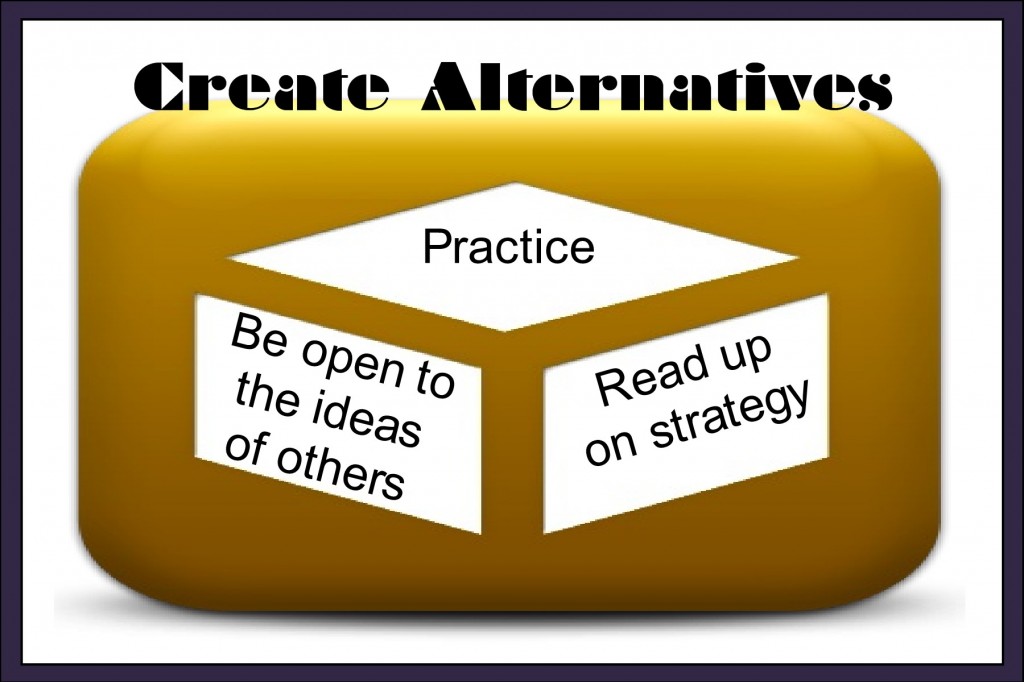Somewhere along the line I had read that being a manager means having to choose between a set of of alternatives, often with limited information. Yes sometimes that happens, but good management practice would suggest the best become experienced at creating additional alternatives and gaining additional information. That is truly a skill of the most successful managers.
They are either adept through experience at seeing alternatives that subordinates and other do not see or creative at developing additional alternatives. Additional alternatives are sometimes the alternative answer to a problem, or the leverage to move the original problem to a more acceptable position.
Example #1
I know of a not for profit organization that leased a dormitory styled building for training temporary special needs residence, over the years the organization that owned the building and the organization which ran the program had become two separate organizations where as they had previously been one organization. Because of the long standing relationship there had never been a lease, just an understanding. As management of the organizations changed and they became more removed from one another the organization owning the property decided to one year, on short notice, double the lease on the property and transfer utility and maintenance responsibility to the group leasing the property, this was an egregious and punitive increase. The alternatives to choose between seemed to be to pay the increase and then look for alternatives, or close the facilities. Building another facility would have taken too long and other traditional dormitory or similar facilities were either too large or not available.
The solution arrived at in a period of sever real-estate depression was to approach the developer of a carriage home community and inquire about buying two connected units and putting a connecting door between the units and creating dorm rooms out of the bed rooms. The mortgage on this acquisition would be less than the original lease and because of the long standing history of the organization, and the state of the market, the developer was willing to carry the mortgage with no dollars down.
The organization leasing the property re-approached the landlord with the idea that they were going to move out leaving the landlord with a special use building and no tenant. A favorable lease was negotiated and the organization is now in discussions to build a second facility with the developer now having time to modify a new carriage home to better fit the organizations needs, relocate young adults into a more community oriented environment and also providing a backup facility in case the landlord decides to again be difficult.
Example #2
A television broadcast station was trying to increase revenue, this was a medium market station in the United States, about the 18th market at the time and the sales staff had become well compensated by working with the existing client list of mostly advertising agencies where the sales effort was pretty well routine as they were working with professionals and did not have to spend a lot of time explaining the advantages of TV advertising as they might have to do with a small business owner. Several attempts were made to encourage the sales staff to reach out to other possible sources of revenue with a minimal effect, and as these were well established salespeople familiar with the market and who could probably gain employment at another station taking much of their client list with them, without much difficulty, the options were limited.
The General Manager came up with an interesting idea. He retained the services, on a part time basis, of the President of the Ex-Stewardess club in the market and armed her with a survey list of questions and a list of small to medium sized businesses to approach to determine their interest. After a few days of surveying the Ex Stewardess came back to report there was no sense in continuing the survey. The people she was talking to wanted to buy. They did not realize they could be on a major market TV station with such ease and for an affordable amount. The General Manager retained six ex-stewardesses on a fixed commission of $125 per package and sent them in to the market with a list of business; in six weeks they sold 375 preset packages worth over $3,000 each thereby demonstrating the ease of obtaining the business. At the regular salesperson commission this would have been about $56,000 in commissions which in the 1970’s was darn good money. After this the salesperson were more aggressive in this area, but never did do as well as the ex-stewardess, so one was retained as a small business sales specialist.
(I have many more examples in my experiences, but I will save those for another day!)
How Do You Develop The Ability to Create Alternatives?
It takes time, experience and a willingness to consider the ideas of others. It is amazing how quick we are sometimes to think we know all the options and do not consider the input of others, we often think we know what they are going to say or assume they do not know our business, or that their experiences are not transferable.
I was at the station where the ex-stewardess were hired and participated in implementing the plan, but when I shared that story with other GM’s at other stations they all said about the same thing, it will never work here, for the little they would have had to invest they were unwilling to even try, they felt they knew better.
I was also with the non-profit as a volunteer when the dormitory issue was resolved. That group had been working with a commercial real-estate agent that had been throwing one idea after another against the wall to see what might have worked, if we had not been willing to listen and work through all the ideas good or bad we would have never gotten to the good ideas.
You also need to have a personal network of experienced business people you can trust, people who have been successful at solving difficult problems, people you can call and say let me run this problem by you to see if you have any thoughts about a solution.
And you need to be a veracious reader, I read almost everything I can get my hands on, sometimes I’ll read a 700 page book and come out with one idea, mining ideas is hard work, but those ideas, solutions, and related problems stick with me and often provide a solution down the road. And these days we have the internet and various forums where we can look for solutions.
Also I am a big proponent of biographies, there is a lot of what a friend of mine calls Horatio Alger books, not that I have not benefited from those as well, but as my friend says, I would rather read about someone who has accomplished the difficult and how they accomplish their successes. I read a lot of political and industrial biographies, they are full of stories of how people overcame substantial challenges, challenges that often make ours pale by comparison. Good management practice takes an open mind, a willingness to listen to others, and the ability to see beyond “walls”. The only thing that boxes in a manager is the manager themselves.
Good luck in your own creative management.
(More ramblings by Petad)


